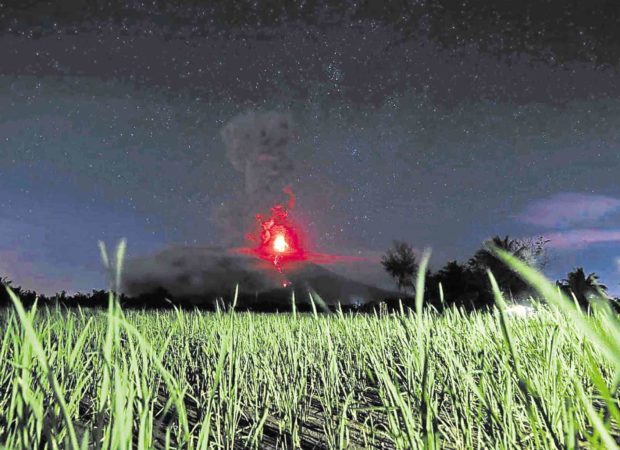Mayon danger zone widened to 8-km radius

FIERY SHOW A clear night sky in Albay province provides a perfect backdrop for Mt. Mayon’s fiery spectacle. The volcano continues to spew ash and lava in this photo taken from the village of Bigaa in Legazpi City at 9:43 p.m. on Monday. —GEORGE GIO BRONDIAL
LEGAZPI CITY — Disaster officials on Tuesday declared “no man’s land” in areas within the 8-kilometer radius extended danger zone (EDZ) as ash from Mt. Mayon continued to fall on towns and cities in Albay province.
This would prohibit villagers from returning to their farms there, according to the Albay Public Safety Emergency and Management Office (Apsemo).
The Apsemo chief, Cedric Daep, said the declaration of no man’s land was a standard practice during past eruptions of Mayon. Police in the 6-km permanent danger zone (PDZ) would man checkpoints to prevent villagers from returning to their homes and farms.
Evacuees
Evacuees are known to return to their homes and farms within the PDZ to look after their animals and crops.
Article continues after this advertisementDaep said the new directive would cover at least 35 villages in the towns of Daraga, Camalig, Guinobatan, Malilipot and Santo Domingo, and in the cities of Legazpi and Ligao.
Article continues after this advertisementA total of 9,906 families or 39,250 people are staying in 35 evacuation centers in the province.
The number is expected to surge following the mandatory evacuation of villagers near the 8-km EDZ and the preemptive evacuation of residents within the 9-km preemptive EDZ in preparation for Mayon’s full-blown eruption that could happen anytime.
On Monday, the Philippine Institute of Volcanology and Seismology (Phivolcs) raised Alert Level 4 (hazardous eruption imminent) after Mayon spewed two successive cauliflower-type ash columns, dumping heavy ashfall on Camalig, Guinobatan, Ligao and other areas in Albay’s third district.
Like thunder
The ash columns were followed by pyroclastic clouds, and lava fountaining and flows.
From Monday night until Tuesday morning, residents of places as far as Legazpi heard Mayon’s rumblings, which many likened to the sound of bass drums or rolling boulders.
Residents who were closer to the volcano said it sounded like thunder, only three times louder and more deafening.
Motorists on the national highway that connects Albay to Camarines Sur province reported minimal to zero visibility due to the thick ash.
Eruptions on Monday and Tuesday, which ejected a 5-km-high ash column, were just “starters” for sustained full-blown eruptions in the coming days, said Eduardo Laguerta, Phivolcs resident volcanologist.
Paul Alanis, Phivolcs science and research specialist, said the eruptions had only sent ash clouds 5 km high, not 10 km as earlier reported.
Ash plume
“We overestimated the height of the ash plume,” Alanis said.
The 2,463-meter volcano has had eruptions described as phreatomagmatic (magma and water driven) types since Monday, four lava fountainings as high as 500-700 meters above the summit and lava flows that cascaded down to the 6-km PDZ.
Due to Mayon’s unrest, Daraga canceled this year’s Cagsawa Festival, previously scheduled for the whole month of February.
Albay Gov. Al Francis Bichara ordered the suspension of work in Guinobatan and Ligao, which were affected by heavy ashfall.
Classes at all levels in Daraga, Camalig, Guinobatan, Ligao and Legazpi were suspended earlier.
As of noon Tuesday, ashfall had affected 178 villages, mostly in towns in the fifth district of Camarines Sur, northwest of Mayon.